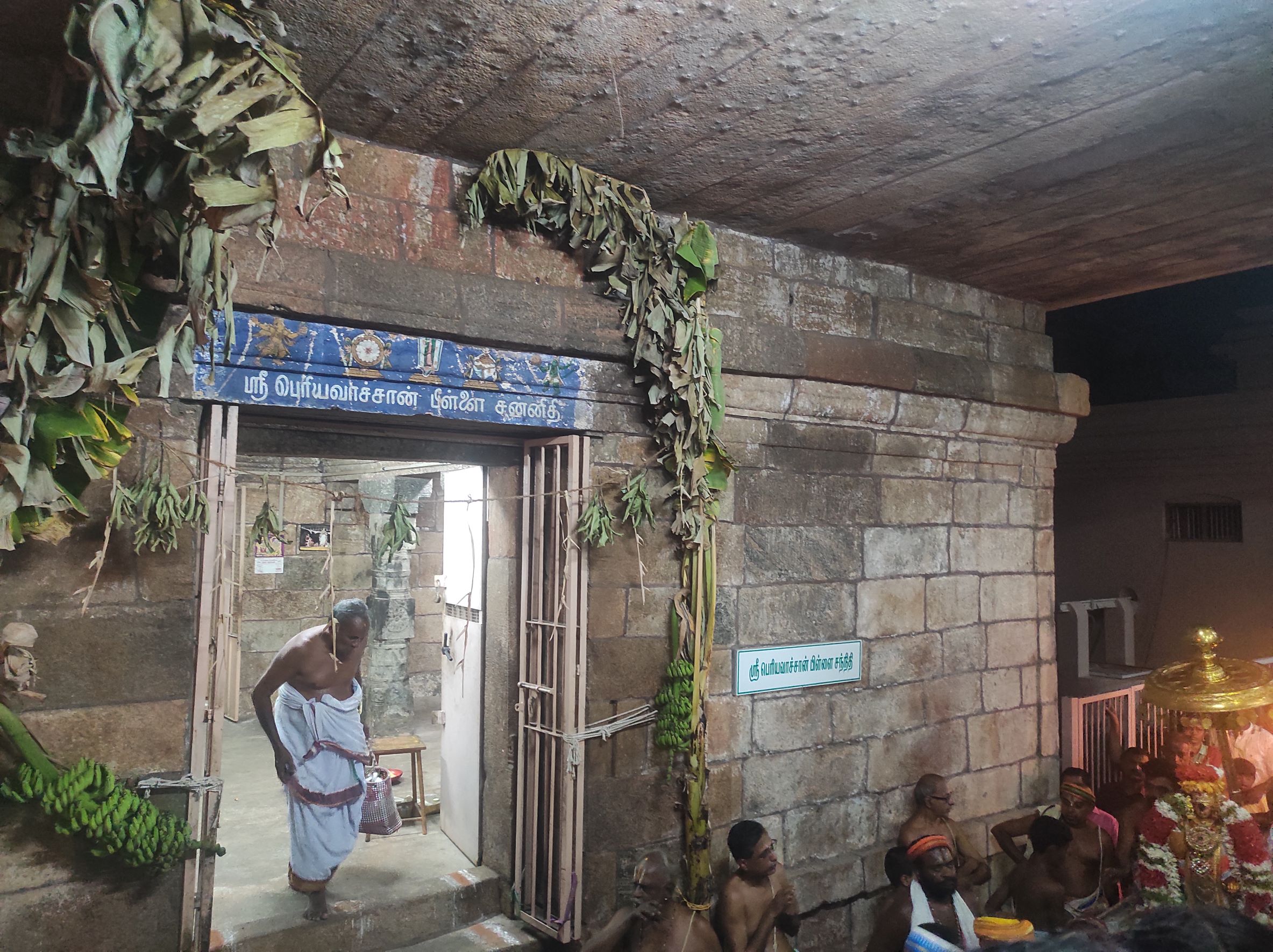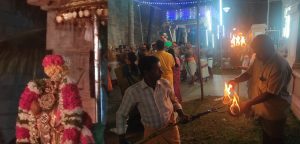Today is the birthday of the early 13th century Sri Vaishnava scholar, who quotes from Vedas and Upanishads in Sanskrit to Thirukkural and Nannul in Tamil in his magnificent Eedu commentary.

Namperumal, the Srirangam utsavar, visits the shrine of 'Vyakhyana Chakravarti' Periyavachan Pillai inside the temple during Vasanthotsavam. Periyavachan Pillai is a disciple of Nampillai, who has himself a commentary on Nammazhwar's Thiruvaimozhi (Prasanna RS)
Thirumangai Azhwar, the uncrowned prince of Tamil poetry, sings to the Lord in the temple of Thirukkannamangai in present-day Thiruvarur district of Tamil Nadu: “O Krishna, who bears a conch in your hand! If you so desire you may attempt to learn the meanings of my poems.”
Tradition has it that Krishna wanted to materialise his desire, but was unfortunately bound by the laws of scripture, by whose norms, he had to remain akin to a material object inside the temple premises. It is, therefore, that both Thirumangai Azhwar (circa late 8th century–9th century CE) and Krishna were reborn as Nampillai (early 13th century CE) the teacher and master orator, and Periyavachan Pillai the student respectively.
Sri Vaishnava hagiographies add credence to the claim of their rebirths by narrating that Nampillai and the saint-poet Thirumangai Azhwar share the same birthday or thirunakshatram (the Karthigai star of the Tamil month of Karthigai, around the time Tamil Nadu celebrates Karthigai Deepam) while Krishna and Periyavachan Pillai share the same Avani month’s Rohini star as their birthdays.
The Sri Vaishnava tradition regards the four anthologies of the saint-poet Nammazhwar as the vernacular Veda and Thirumangai Azhwar’s six compositions as the Angas (subsidiary texts) to Nammazhwar’s scripture.
Just as Thirumangai Azhwar was born to further the meanings of Nammazhwar’s texts through his poetry, he was now reborn as Nampillai to elaborate the meanings of Nammazhwar’s magnum opus, the Thiruvaimozhi. He would do so through a detailed discourse at the premises of the Srirangam temple, attended by none other than Krishna himself, as his student Periyavachan Pillai.
It was as if Krishna was not content on being present amongst the listeners as Periyavachan Pillai, the Sri Vaishnava texts narrate, that Ranganatha, the deity of Srirangam in whose temple complex Nampillai was lecturing on the Thiruvaimozhi, wanted to listen to Nampillai’s genius oration. He was prepared to transgress the scriptural prescription of being unmovable in a temple sanctum.
The huge figure of Ranganatha in Srirangam is said to have woken up from his reclining stance to peep out of his sanctum room in a bid to hear Nampillai with better clarity. Fortunately, the only man nearby was the ‘Tiruvilakkuppicchan’, or the lamp bearer of the shrine, who quickly pushed the deity back to his original position and tucked him in his serpent bed.
Nampillai’s mastery of Sanskrit and Tamil sources and his insightful intellect flowed in a unique style of Manipravalam, (a hybrid idiomatic language used by the Sri Vaishnavas for commentarial prose) contextualising, explaining, adding theological colour, and responding to Purvapakshas (apparent fallacies) to the poems of Nammazhwar.
It is natural that his discourses drew a lot of crowds. People were mesmerised by the aesthetic experience of Azhwar’s poetic essence. A famous idiomatic expression that is still in vogue amongst the Sri Vaishnavas goes “Namperumal Goshtiyo, Nampillai Goshtiyo!” i.e. “Is this the crowd of our Lord or is it that of Nampillai?”
People of his times were said to have been confused between the huge crowd that gathered to see the deity and offer worship and those that came to hear the detailed expositions of Nampillai.
It is no wonder if a place of worship attracted a large number of people. But if public memory is shaped by the narrative of a scholar’s nuanced exposition of theologically charged arguments based on a highly evolved classical text of high poetic merit drawing huge crowds, it is definitely a testament to Nampillai’s exposition.
It was his student Vadakku Thiruveedhi Pillai who took on the arduous task of transcribing his guru’s words on manuscripts and preserving them for posterity.
As an academic working on Nampillai’s commentary titled “Eedu 36,000 Padi”, I have been truly drawn into the style, depth, and beauty of his genius.
It was Nampillai’s other student, Periyavachan Pillai, who is credited with the composition of nectarine commentaries on all the 4,000 verses of the Azhwars and is known with the epithet Vyakhyana Chakravarti (the emperor of commentaries).
Nampillai can be called the Himalayas of Vaishnava commentary from whom spring many nourishing rivers that flourish the literary plains of the Tamil world.

The Srirangam utsavar (bronze) idol, called Namperumal, during the Vasanthotsavam in 2022 (Prasanna RS)
The Thenkalai Sri Vaishnava tradition records in its hagiographies that the preceptor Manavala Mamuni (15th century CE) lectured for a year, explaining the beauty of Nampillai’s commentary in the temple of Srirangam.
It is believed that Ranganatha stopped all his festivals for a year to pay exclusive attention to Mamuni’s exposition of Nampillai’s treatise. At the end of a year-long literary festival, Ranganatha is said to have offered a verse of praise, arriving as a young boy and prostrating himself before the ascetic as a measure of reciprocity for the wondrous narration of the Eedu 36,000 Padi.
Nampillai’s treatise approaches Thiruvaimozhi in two distinct ways.
To a person who is an outsider to the Sampradaya, it posits Thiruvaimozhi as a vernacular scripture that embodies the theological ideas of the tradition, capable of refuting other world views. To an insider, it shows Thiruvaimozhi as a revered, free-flowing experiential poetry, aesthetic, and unparalleled in devotional experience.
He presumed the task of anachronistically subsuming the verses of Nammazhwar to reflect the values of the Sri Vaishnava tradition whose genesis was a few centuries later than Azhwar himself.
Let me demonstrate Nampillai’s mind by introducing a small section of his entry to the text called the ‘Sriyahpatipadi’.
He begins by summarising the philosophical outlooks of various schools of thought such as Lokayatika (materialist), the many schools of Buddhism, the Naiyayikas (logicians), Vaiseshikas (atomists), Pashupatas, and so forth, only to refute them and state his own school later.
Nampillai, therefore, does not approach the poetic outpourings of Nammazhwar as mere hymns of devotion, but as a scripture of theology, a vernacular Veda. He then proceeds to establish Nammazhwar as a person who was blessed, without any reason whatsoever by God to possess the right knowledge to refute the outsiders (those who deny the Vedic scripture) and the ill-eyed (those who accept the validity of the Vedas, but not the supremacy of Narayana).
Nampillai, while systematically concluding his discussion with the claim that Nammazhwar was the blessed one, presumes another opponent. He tries to refute the authority of Thiruvaimozhi citing language (Tamil, and not the liturgical Sanskrit), the caste of the author (Vellala, not a Brahmin), and the genre of poetry (love).
He quotes anecdotes from the Puranas and other scriptures to refute these objections and establish that Azhwar’s songs are divine outpourings. He goes on to say that these songs were not conscious acts of composition, but were inevitable bursts of devotion.
Nampillai’s need for reason would not rest there. He would go on to raise another question saying “if they are outpourings in an ecstatic state of being, how are they perfect in grammar, metrical feet and divided accurately based on the number of songs and compiled as an anthology?”
To this, he skilfully replies saying: “Well, If the Ramayana, born through the auspices of Brahma, a mere demi-God’s blessings can be of excellent poetic merit, Azhwar’s songs were born out of the Supreme Being’s bestowals, and therefore have no qualms in being true to grammar!”
Albeit a small glimpse into a voluminous text, these examples help us understand his methodical mind.
The 1,000-song anthology of Nammazhwar is divided into 100 tens, and before moving into each ten, Nampillai presents an Avatarikai (the descent), setting the context in whose light he interprets the verse.
He presents another short Avatarikai before every song, giving the reader a Sangati (a link) between the previous song and the instant one. He introduces every word, at times dwelling on its grammatical usage, adding glosses to them by switching freely between Tamil and Sanskrit.
He also gives the Anvya (syntax/prose order) in which the verse is to be read. Once such a systematic base is developed, he proceeds to explain every word by adding context, refuting opponents that he introduces to his audience and augmenting the narrative through quotations from various sources, and so forth. He also makes use of anecdotes (Aitihyas) and records certain interpretations (Nirvahas) offered by his teachers to explain certain phrases. This is Nampillai creating a written record of many oral traditions of his times.
Nampillai quotes from a range of literature. He handles Sanskrit texts such as the Vedas, Upanishads, Itihasas, Puranas such as the Bhagavatam, texts of other traditions that he cites to refute, Kavyas, poetic works of his preceptors and so forth. In Tamil, he handles with ease the many poems of the Azhwars, Thirukkural, grammatical texts such as the Nannul, texts of Tamil poetics, and so forth.
It is today that he was born. Just as earthen lamps shine on every doorstep of Tamil Nadu during this period, may the many lamps lit by literary masters such as Nampillai shine in our hearts.
(Prathik Murali is a research scholar in the Department of Religion at the University of Florida. His research interests are broadly on South Asian religions. He is working on Nampillai’s commentary titled “Eedu 36,000 Padi”. He has a master’s degree in historical studies and a graduate diploma in manuscriptology)

Feb 28, 2024

Feb 18, 2024

Feb 12, 2024

Feb 11, 2024

Feb 06, 2024

Aug 29, 2023